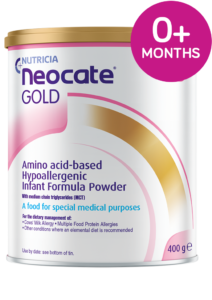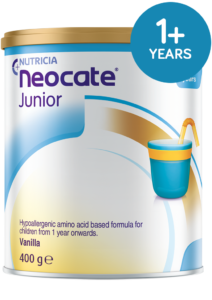How is cows’ milk protein allergy diagnosed?
Key takeaways
- Identify symptoms of cows’ milk protein allergy
- Learn about when to visit a doctor or healthcare professional for diagnosis is indicated
- Understand the common tools used by healthcare professionals for the diagnosis of cows’ milk protein allergy

What are the common symptoms of cows’ milk protein allergy?
If you suspect that your child may have a cows’ milk protein allergy, it is important to seek advice from your child’s doctor. A reliable diagnosis can ensure that your child does not unnecessarily avoid cows’ milk and all the nutrients it provides.
If your child has cows’ milk protein allergy; the symptoms may occur either immediately or delayed.1 Immediate reactions to cows’ milk protein occurs straight away after consumption. These reactions are usually quite obvious and are therefore easier to pick up e.g. hives, noisy breathing or wheezing, anaphylaxis. Delayed reactions occur much more slowly, up to a few hours or sometimes a few days after consuming cows’ milk protein. These reactions are not as obvious and can make diagnosis more difficult e.g. colic, reluctance to feed.
What might a doctor’s appointment look like for suspected cows’ milk protein allergy?
Your doctor will want to ask a lot of questions about your child’s medical history and symptoms, as this will help them come to a diagnosis.1 They may also want to perform allergy testing.1,2 Unfortunately, cows’ milk protein allergy cannot be definitively diagnosed by a single test. The diagnosis may take time, particularly if your child has a delayed reaction to cows’ milk.
How can you best prepare yourself for the doctor’s visit?
If you think your child may have a delayed reaction to cows’ milk, it is important to keep a food and symptoms diary. If you are solely breastfeeding or mixed feeding, then this should also be a diary of the foods you have eaten. A symptom checklist may help with this, you can find one here.* Identifying the symptoms of cows’ milk protein allergy is the first step towards providing relief for your child.
Your child’s medical history will also be an important part of the diagnosis. It is a good idea to think about this before your appointment. Your doctor may ask about other medical conditions, in particular allergic conditions such as other allergies, asthma and eczema. Your doctor will also want to know about whether you or your partner or your child’s siblings suffer from allergies.
You will, of course, have many questions for your doctor. To ensure you don’t forget anything, you may find it helpful to take a written list of questions to the appointment. Some questions you might like to ask your healthcare professional may include:
- Could my child’s symptoms be caused by a food allergy?
- Is it possible to confirm my child’s food allergy?
- Which tests will have to be performed?
- Do I need to see a specialist?
- What will be the next steps?
Which diagnostic tests might your doctor want to perform?
Along with collecting your child’s medical and symptom history, your doctor may also perform allergy testing. There are a number of different tests that are used to help diagnose food allergies. These can involve skin or blood tests as well as other diagnostic tests.2
The most suitable allergy tests will depend on the type of reaction and symptoms your child is displaying. For immediate reactions, also known as IgE mediated reactions, skin prick tests or blood tests for allergen-specific IgE may be performed.1,2 For delayed reactions, also known as non-IgE mediated reactions, a dietary elimination and/or an oral food allergen challenge may be chosen.1,2
IMPORTANT:
All these tests must be performed under medical supervision by a formally trained healthcare professional. Allergy diagnosis using unproven tests such as Vega, kinesiology, or Alcat are not recommended.2
|
Skin Prick Testing (SPT)3 |
Skin prick testing (SPT) is usually performed on the forearm or back. The area is first cleaned and then small drops of the suspected allergens are placed on the skin. A small prick is then made through each drop into the skin. If the child’s skin becomes red and itchy, it usually means that they are allergic to that particular allergen. This is called a positive reaction. If no reaction is shown in this test, there is still a chance of your child being allergic to that food. This can happen in delayed or non-IgE mediated reactions. The results of SPT are available in about 20 minutes and for this reason, they are often used as the first method of allergy testing. SPT should only be performed by a healthcare professional who is trained in the procedure and who is able to interpret the results. |
| Serum specific IgE tests3 | Serum specific IgE tests are blood tests that can measure the concentration of particular antibodies in the child’s blood. These antibodies, known as IgE antibodies, are released in response to food allergens. This test is often performed when skin prick testing is not possible. |
| Dietary elimination | This diagnostic diet involves eliminating the suspected food allergen (cows’ milk protein) from your child’s diet, or the breastfeeding mother’s diet.2 Removing cows’ milk and dairy may limit the intake of some important nutrients so it is important for this diet to be completed with medical supervision and support. The suspected problem food will usually need to be avoided for two to four weeks, although the length of time may vary depending on your child’s symptoms.1 If there is no change in your child’s symptoms, then your doctor may look for a different diagnosis. |
| Food allergen challenge3 | This test involves consuming very small amounts of a food allergen (like cows’ milk protein) under medical supervision.3 If a reaction is observed, it is likely that the child is allergic to that particular food. This test is sometimes used to confirm a diagnosis in children when the cause of a severe allergic reaction has not been confirmed. |
The Symptoms Checklist
If you think your child may have a delayed reaction to cows’ milk, it is important to keep a food and symptoms diary. If you are solely breastfeeding or mixed feeding, then this should also be a diary of the foods you have eaten. A symptom checklist may help with this, you can find one here.
The Symptoms Checklist is not intended to be a substitute for medical advice. Always consult your doctor.
Download ChecklistReferences:
- Australasian Society of Clinical Immunology and Allergy (ASCIA). Cows’ milk (dairy) allergy 2019. Available from: http://www.allergy.org.au/patients/food-allergy/cows-milk-dairy-allergy (Accessed June 2021).
- Better Health Channel. Cow’s milk allergy 2017. Available from: Cow’s milk allergy – Better Health Channel (Accessed June 2021)
- Australasian Society of Clinical Immunology and Allergy (ASCIA). Allergy Testing 2020. Available from: Allergy testing – Australasian Society of Clinical Immunology and Allergy (ASCIA) (Accessed June 2021)






